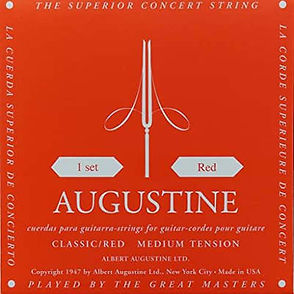


Choosing the Right Guitar Strings
The first step in selecting guitar strings is to identify the type of guitar you own. Is it an acoustic, electric, classical, or a specialty variant like a 12-string or bass guitar?
Different guitars require specific types of strings, and using the wrong ones can result in poor performance and sound quality. Take note of your guitar's specifications before moving forward.
Strings intended for steel string guitars, for example, should never be used on classical guitars because the greater tension of metal strings can do irreparable damage to the instrument's neck and joints.
As well, nylon strings will never function properly on a steel string guitar. They aren't designed for a steel string bridge, won't fit the nut properly, the fingerboard is too narrow and curved for them to vibrate properly, and the reduced string tension can warp and bow the neck.
Here are some common options:
A. Nickel-Plated Steel: These strings are known for their bright and balanced tones, making them versatile for a wide range of music genres.
B. Stainless Steel: If you're into rock or metal, stainless steel strings are a great choice. They provide bright tones with increased sustain and durability.
C. Pure Nickel: If you're a fan of blues, jazz, or vintage sounds, pure nickel strings offer a warmer, mellower tone that can enhance your playing style.
D. Phosphor Bronze/Bronze: These materials are commonly used for acoustic guitars. Phosphor bronze strings produce a warm and rich tone, while bronze strings provide a bright and crisp sound
E. Silk and Steel Strings: These are made with silk filaments under the winding. They produce a softer, warmer tone, and are generally easier to play. The reduced string tension in lighter gauges also makes these strings a good choice for older vintage guitars.
Silk and steel strings area also a good solution for someone who wants to put nylon strings on a steel-string guitar. They have almost the same tension as nylon strings, and work well on steel-string bridges and fingerboards.
F. Classical Strings: They are usually all nylon with the bottom thicker 3 strings wrapped in a fine
wire and the top three strings in plain nylon. They come in low medium and high tension. They generally have a warmer tone and are a little quieter. They are mostly used for classical, folk and flamenco styles.
Metal guitar strings come in different gauges, referring to their thickness. Lighter gauge strings are generally easier to play, bend, and fret, making them ideal for beginners and players who prefer a lighter touch.
On the other hand, heavier gauge strings offer fuller tones and are popular among experienced players or those who play in lower tunings.
Common gauge ranges for electric guitars include light (.009–.042), regular (.010–.046), and heavy (.011–.049). Acoustic guitars typically use light (.010–.047) or medium light (.011–.050) or medium (.012–.053) gauge strings, among others.
Experiment with different gauges to find the tension that suits your playing style and preferences.
Consider your playing style and the music genre you primarily focus on. If you play aggressive styles like heavy metal, you may prefer heavier gauge strings for better durability and tone under high tension.
Lighter gauge strings are often suitable for fingerstyle playing or genres like folk or indie. Think about the sound you want to achieve and the techniques you employ and choose strings that complement your style.
Coated strings such as Elixir are usually more expensive but have a silkier feel and last longer
as their coating process slows down their degradation.
A cross section of a coated string showing the coating, winding and inner core.
Ultimately, choosing guitar strings is a personal and subjective process. What works for one guitarist may not work for another. It's crucial to experiment with different brands, materials, and gauges to find your perfect match. Seek recommendations from other guitarists, read reviews, and try out various options until you discover the strings that feel and sound right to you.
Selecting the right guitar strings is a crucial step toward achieving the desired tone and playability on your instrument. By understanding your guitar, exploring different materials and gauges, considering your playing style and genre, and allowing room for experimentation, you can find the strings that bring out the best in your playing. Remember, the journey to finding your perfect sound is a personal one, so take your time, enjoy the process, and let your strings inspire you to create beautiful music.


Rotosound strings based in Sevenoaks Kent have been manufacturing high quality strings for decades. They are considered to be some of the best strings in the world for guitar, bass, mandolin, banjo and many other stringed instruments. Here are some bass strings being shown to The Pink Floyd circa 1969.
